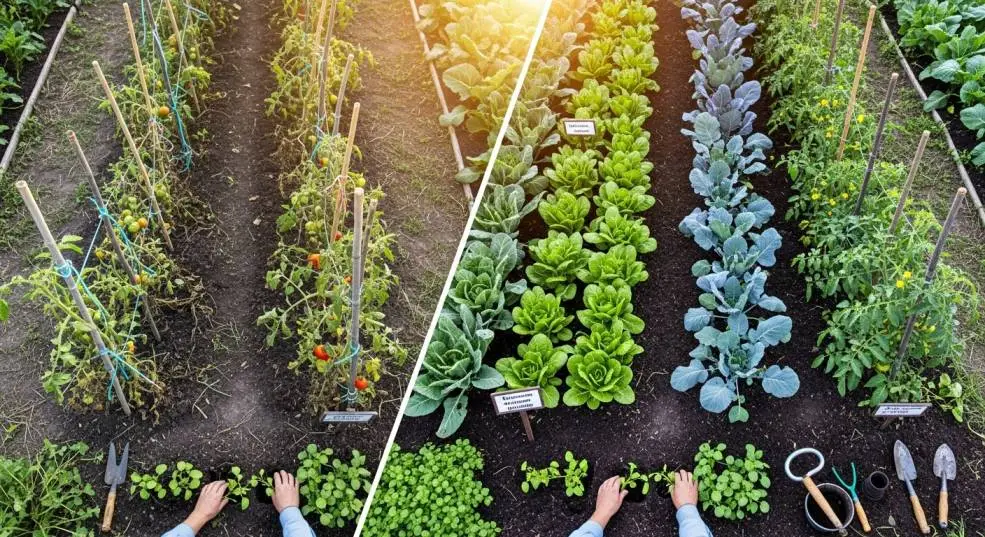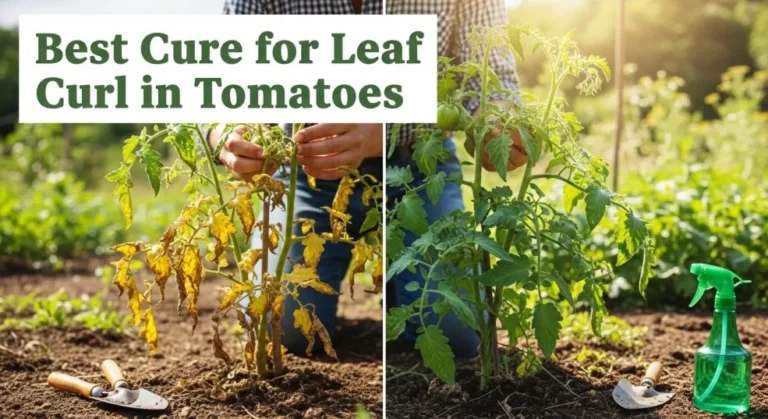Natural light and colorful flowers are great for both your indoor spaces and your garden.
If you’re planning to plant something new after tomatoes, you’re on your way to a year-round harvest and a healthier garden.
Let’s look at how to keep your garden thriving after tomato season. Focus on taking care of your soil, rotating your crops, and choosing the right plants to enjoy a rich harvest every season.
Clean and restore the soil
Once you’ve harvested your last tomato, give your garden bed some TLC. Tomatoes are known for depleting nutrients, so it’s essential to tidy up and rejuvenate that patch before introducing new crops.
Remove old plant debris
- Pull out any remaining tomato stems and foliage to reduce pest and disease risks.
- Rake the topsoil lightly, collecting fallen leaves and any decaying matter.
- Compost healthy debris to return nutrients to your garden later.
Turn and loosen the soil
- Use a garden fork or spade to lift and break up compact soil.
- Work in slow, gentle motions to preserve beneficial organisms.
- Add compost or well-rotted manure, mixing it through the top six inches of soil to boost nutrients.
Rotate your crops for balance
After harvesting tomatoes, think about planting a different type of vegetable to keep your soil healthy. A good rotation plan helps your garden stay fertile and keeps pests guessing.
Choose different plant families
Tomatoes belong to the nightshade family, so moving to beans or sweet peas (legumes) can restore nitrogen levels. Rotating to a leaf crop like spinach or lettuce can also be a fun shift—imagine diving into fresh salads grown right where your tomato plants used to thrive.
Space out your rotations
Create a simple plan for your garden layout. Avoid planting tomatoes in the same spot for at least two years. This helps prevent diseases and keeps the soil in good shape. It’s like changing up your workout routine to keep things fresh.
Pick complementary vegetables
If you want variety on your dinner plate, consider planting vegetables that grow well in cooler weather or don’t face the same problems as tomatoes. Broccoli, kale, and carrots are great options, especially as the days get shorter.
Extend the harvest
If you’d rather carry a couple of tomato plants through the cold, here’s how to overwinter tomato plants for an earlier spring harvest and steady winter snips.
- Cool-season crops like cabbage, cauliflower, or even Brussels sprouts can keep your garden busy.
- Root veggies, such as radishes or beets, are quick to mature and fit nicely into post-tomato soil.
Enhance flavor and nutrition
Broccoli and kale, for instance, can add a savory twist to your menu. Plus, their robust root systems help break up the soil, making it easier for the next planting cycle.
Try herbs and flowers
Seasonal planting after tomatoes doesn’t have to be limited to vegetables. Herbs and flowers can refresh your space while enriching the garden ecosystem.
Go for pollinator-friendly blooms
- Marigolds or zinnias invite beneficial insects that feast on damaging pests.
- Nasturtiums attract aphids away from more valuable plants, acting like a decoy.
Grow your favorite herbs
- Basil and oregano may have played well with your tomatoes, but they can also thrive independently in a post-tomato bed.
- Rosemary, thyme, and sage do particularly well in well-draining soil, so feel free to keep them going year-round (if temperatures allow).
Enrich the soil with nutrients
A healthy garden is a well-fed garden. Without the right minerals and organic matter, your new plants may struggle to reach their full potential.
Test soil pH
Garden stores often carry easy-to-use kits. You’ll want to ensure the pH level suits whichever crops you plan to grow next. Leafy greens love slightly acidic conditions (around 6.0 to 7.0). If the pH is off, incorporate lime (to raise) or sulfur (to lower) in moderate amounts.
Encourage beneficial microbes
- Add a layer of organic mulch, like straw or wood chips, to the soil surface.
- This mulch helps to retain moisture and breaks down into valuable nutrients.
- Avoid synthetic chemicals that might harm earthworms or microorganisms that keep soil biologically active.
Plan your next steps
As the seasons shift, think about your garden’s long-term goals. It’s easy to focus on just one round of planting, but continued planning leads to richer harvests down the line. Whether you’ve got a sprawling backyard or a cozy raised bed, planning ensures you’re never caught off-guard in any season.
Create a seasonal calendar
- Note down approximate planting and harvesting dates for each chosen crop.
- Highlight times to fertilize, water thoroughly, and rotate again.
- This approach helps you anticipate when you might need extra compost or new seedlings.
Blend aesthetics with productivity
If you prefer a colorful garden, rotate in ornamental herbs and dwarf flowers among your produce. Keeping your garden visually interesting makes it more motivating to maintain, especially in cooler months when you might be tempted to stay indoors.
Keep learning and experimenting
Gardening is equal parts art and science. You might discover that certain crops absolutely love your post-tomato soil while others aren’t so thrilled. That’s totally normal—gardens have personalities, and flexing to meet those quirks is half the fun.
Observe and record
Keep track of what grows well and what doesn’t. If you didn’t get much broccoli, try adding more compost or changing when you plant next time. Treat your garden like a fun experiment, and you’ll become a better gardener over time.
Seek local advice
Talk to local gardeners or join a community garden group to learn about your area’s weather and soil. A chat with a neighbor who has gardening experience can help you avoid problems.
Wrap up and celebrate growth
After harvesting tomatoes, it’s time to plant new crops and keep your soil healthy. This is a great chance to discover what your garden needs and to bring new tastes and colors to your meals.
With a good planting plan and some care for your soil, you can enjoy fresh harvests long after tomato season ends.
Why not try something new, like a row of crisp lettuce or some bright marigolds? Small changes can make your garden healthier and more vibrant all year.
As you make adjustments, remember to enjoy the process. Every time you dig in the soil or notice a sprouting seedling, you’re connecting with nature and helping your garden grow.




Leave a Comment